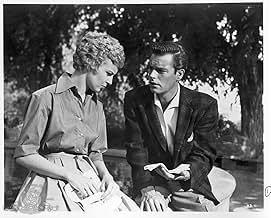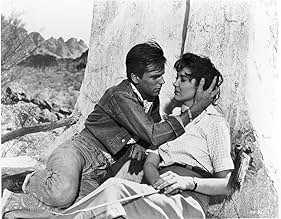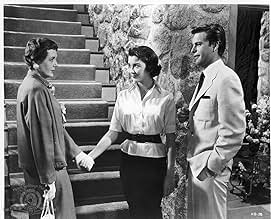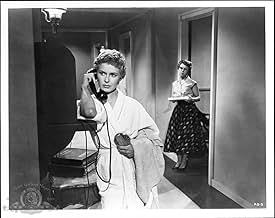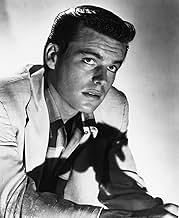AVALIAÇÃO DA IMDb
6,7/10
4,7 mil
SUA AVALIAÇÃO
Adicionar um enredo no seu idiomaA ruthless college student resorts to murder in an attempt to marry an heiress.A ruthless college student resorts to murder in an attempt to marry an heiress.A ruthless college student resorts to murder in an attempt to marry an heiress.
- Direção
- Roteiristas
- Artistas
Albert Cavens
- Restaurant Patron
- (não creditado)
Robert Ivers
- Student at Murder Scene
- (não creditado)
Mickey Martin
- Student
- (não creditado)
Joe McGuinn
- Chemistry Professor
- (não creditado)
Edwin Rochelle
- Restaurant Patron
- (não creditado)
Jack Stoney
- Policeman
- (não creditado)
- Direção
- Roteiristas
- Elenco e equipe completos
- Produção, bilheteria e muito mais no IMDbPro
Avaliações em destaque
Oh, how to resolve the age-old problem of accidentally getting your girlfriend preggers? Well, if you're a good-looking, psychopathic college boy, as portrayed by Robert Wagner in the 1956 thriller "A Kiss Before Dying," the answer is fairly simple: Just knock her off and hope for the best...and pray that her snoopy sister won't start nosing around! Anyway, that's the setup for what turns out to be in essence a poor man's "A Place in the Sun" (1951), but nevertheless a film that remains quite entertaining in its own right. Based on an Ira Levin novel, directed by cult favorite Gerd Oswald, and featuring beautiful, wide-screen color filming (shown to good advantage on the DVD that I just watched), the film certainly does impress. Joanne Woodward comes off very sympathetically here in her third film, and supporting players Mary Astor (a 50-year-old redhead in this picture), George Macready (less hissable than usual) and Jeffrey Hunter (who will ALWAYS be Capt. Pike to me!) are all very fine. But Wagner certainly does steal the show as the pretty-boy whacko. Storywise, I'd say that the plot is a wee bit on the far-fetched side, but never absurdly so, and that most viewers will easily foresee how Wagner will slip up in the end. Still, the film remains suspenseful throughout and concludes most satisfactorily. Strange that the "abortion" word is never brought up, though. Could Wagner's character be a pro-lifer who's into murder? He wouldn't be the first!
If you're looking for an adaptation of the Ira Levin book--this isn't it. Also the book would be impossible to film. That aside this is OK murder mystery-thriller. I was lucky enough to see it letter-boxed on TCM--it looks great! However a film dealing with a psycho and murders he commits does NOT need a theme song! Acting is OK--not good, not bad, just OK. The cast is attractive, the film is beautiful to look at and it's an interesting diversion for 1 1/2 hours. So, an OK thriller--nothing really inventive or different about it. At all costs, AVOID the terrible 1991 remake! That one is a TOTAL waste of time!
I read Ira Levin's book when I was young, sometime in the 1960s, and loved it. It's very chilling, and I think as good as Rosemary's Baby. Better than the Stepford Wives and Boys from Brazil.
This film is a quite bizarre mixture of the chilling and the comical. Someone above has mentioned the scene where Bud and Dorie are having an intense conversation when suddenly a middle-aged woman in a completely see-through blouse with a great big bra underneath walks between them and halts the conversation; she has nothing whatsoever to do with the plot, and when it happened I literally burst out laughing at the incongruousness of it. I also laughed at Jeffrey Hunter's ridiculous attempts to manipulate heavy Clark Kent spectacles and an unlit pipe in a vain attempt to appear mature.
The good points about the film are the plot, which is gripping even though it's been shortened markedly from the book, and some of the acting, particularly Robert Wagner and Joanne Woodward -- and I also enjoyed George Macready as the father of Dorie and Ellen.
The fact is that I was consistently interested or amused or gripped by something or other for the whole of the film. You can't really ask for much more from a film.
This film is a quite bizarre mixture of the chilling and the comical. Someone above has mentioned the scene where Bud and Dorie are having an intense conversation when suddenly a middle-aged woman in a completely see-through blouse with a great big bra underneath walks between them and halts the conversation; she has nothing whatsoever to do with the plot, and when it happened I literally burst out laughing at the incongruousness of it. I also laughed at Jeffrey Hunter's ridiculous attempts to manipulate heavy Clark Kent spectacles and an unlit pipe in a vain attempt to appear mature.
The good points about the film are the plot, which is gripping even though it's been shortened markedly from the book, and some of the acting, particularly Robert Wagner and Joanne Woodward -- and I also enjoyed George Macready as the father of Dorie and Ellen.
The fact is that I was consistently interested or amused or gripped by something or other for the whole of the film. You can't really ask for much more from a film.
According to Alicia Malone, the beautiful and intelligent host at tcm, "A Kiss Before Dying" is considered by Joanne Woodward to be not only her worst picture but the worst picture ever made by Hollywood. Oh c'mon, Joanne, considering some of the turkeys that I have seen with you and your late husband, Paul Newman, you can't possibly be serious. Don't get me wrong. Everyone is entitled to a living, and it's nice work if you can get it. At any rate, considering that Dore is supposed to be a bit of a whining nebbish, Joanne plays the part quite well.
I couldn't help from comparing this story, originating from Ira Levin's novel, to that of Theodore Dreiser's "An American Tragedy" which was adapted to the silver screen as "A Place in the Sun". While Levin's and Dreiser's stories both center on the very determined ambitions of two young men from very modest, if not impoverished, backgrounds, the big difference is that George Eastman (Montgomery Clift) in "Place in the Sun" does not deliberately kill the woman he impregnates. He only WANTS to kill her in the worst way and then does nothing to help her when she, herself, manages to overturn their rowboat on Loon Lake. This significantly distinguishes Eastman from Bud Corliss (Robert Wagner), who, to me, is far less sympathetic and far more depraved than George. The scenes at the closed marriage license offices in both films are also very similar.
The entire cast is excellent, and I would argue that this is among Mr. Wagner's best roles as an unlikely psychopathic murderer. Noteworthy is his brief scene with Mary Astor when he scolds her, his mother, for her wardrobe choice moments before he introduces her to his wealthy girlfriend's family. This one scene defines his character and gives us an important glimpse of at least some of the circumstances behind his motivation. Are the short haircuts of both Mom and Dore a mere coincidence, or is there much more lurking behind that similarity? Mary Astor, an outstanding actor, has always contributed greatly to all of the movies in which I have seen her, including "Act of Violence", "Dodsworth", and "The Maltese Falcon", only a few that immediately come to mind. George Macready, including his distinctively resonant voice, is another seasoned professional whose appearance is a very welcome bonus here. I thought that Virginia Lieth acts very decently, and she looks beautiful, so I don't know why I have never seen her in any other film.
The technicolor photography of cinematographer Lucien Ballard on location in and around Tucson, Arizona, including the campus of the University of Arizona, is exceptional. There is a noticeable crispness to it as it captures the unique architecture and natural surroundings of 1956 Tucson, days that only survive as they are archived by films such as this. Note the copper colored Thunderbird that Dore Kingship drives as well as the corded telephone and the swimming pool ladders of the same color. Someone had a barrel of fun making this picture.
As is the case with any film, there are some peculiar instances, including the reluctance of Dwight Powell at least to attempt to fight for his life. And where is the truck driver at the end? I expected him to appear immediately at the scene instead of hiding in his cab until the police arrive. And does Bud actually push Ellen out of the path of danger, as I believe he does? Also, if Bud's service during the Korean War is a factor behind his behavior, this should have been developed more as it should have but wasn't in the case of George Loomis (Joseph Cotton) in "Niagara", another favorite of mine from the same era.
I couldn't help from comparing this story, originating from Ira Levin's novel, to that of Theodore Dreiser's "An American Tragedy" which was adapted to the silver screen as "A Place in the Sun". While Levin's and Dreiser's stories both center on the very determined ambitions of two young men from very modest, if not impoverished, backgrounds, the big difference is that George Eastman (Montgomery Clift) in "Place in the Sun" does not deliberately kill the woman he impregnates. He only WANTS to kill her in the worst way and then does nothing to help her when she, herself, manages to overturn their rowboat on Loon Lake. This significantly distinguishes Eastman from Bud Corliss (Robert Wagner), who, to me, is far less sympathetic and far more depraved than George. The scenes at the closed marriage license offices in both films are also very similar.
The entire cast is excellent, and I would argue that this is among Mr. Wagner's best roles as an unlikely psychopathic murderer. Noteworthy is his brief scene with Mary Astor when he scolds her, his mother, for her wardrobe choice moments before he introduces her to his wealthy girlfriend's family. This one scene defines his character and gives us an important glimpse of at least some of the circumstances behind his motivation. Are the short haircuts of both Mom and Dore a mere coincidence, or is there much more lurking behind that similarity? Mary Astor, an outstanding actor, has always contributed greatly to all of the movies in which I have seen her, including "Act of Violence", "Dodsworth", and "The Maltese Falcon", only a few that immediately come to mind. George Macready, including his distinctively resonant voice, is another seasoned professional whose appearance is a very welcome bonus here. I thought that Virginia Lieth acts very decently, and she looks beautiful, so I don't know why I have never seen her in any other film.
The technicolor photography of cinematographer Lucien Ballard on location in and around Tucson, Arizona, including the campus of the University of Arizona, is exceptional. There is a noticeable crispness to it as it captures the unique architecture and natural surroundings of 1956 Tucson, days that only survive as they are archived by films such as this. Note the copper colored Thunderbird that Dore Kingship drives as well as the corded telephone and the swimming pool ladders of the same color. Someone had a barrel of fun making this picture.
As is the case with any film, there are some peculiar instances, including the reluctance of Dwight Powell at least to attempt to fight for his life. And where is the truck driver at the end? I expected him to appear immediately at the scene instead of hiding in his cab until the police arrive. And does Bud actually push Ellen out of the path of danger, as I believe he does? Also, if Bud's service during the Korean War is a factor behind his behavior, this should have been developed more as it should have but wasn't in the case of George Loomis (Joseph Cotton) in "Niagara", another favorite of mine from the same era.
He may not have been James Dean, but Robert Wagner delivers a career performance in this sorely neglected sleeper from 1956. The first half is a beautifully shaded dance of death as Wagner plots to rid himself of the inconveniently pregnant Joanne Woodward. He's all sincere insincerity from one rendezvous to the next, while she wants desperately to believe, even against all odds. Has there ever been a more cold-hearted manipulator of vulnerable feminine desires. Dory (Woodward) is all whiney expectations, while Wagner conceals ruthless ambition behind a pretty boy mask.
Director Gerd Oswald's staging of the first half is little short of brilliant, and had the filming been in appropriate black and white, a latter day noir classic would have resulted. Notice how subtly Woodward expects to be kissed atop the municipal building, the pinnacle of her girlish dreams, while Bud (Wagner) callously lights a cigarette, defiant of normal expectations. And what a gripping piece of morbid psychopathology is Wagner's slip-sliding through the chemistry lab as he prepares a toxic.potion for his lady love. Maybe in the last analysis, Bud's problem lies with his mother. The fixation is certainly not normal, as she senses in putting off his request for a "date". Yet Bud's social climbing ambitions are made tellingly clear that they are for mom as well as for himself.
Unfortunately, the second half reverts to standard Hollywood convention, the suspense subsiding along with the first-rate mood music. Putting a pipe in the callow Jeffrey Hunter's mouth and making him a college professor amounts to a crippling miscalculation on someone's part. Hunter's simply not the type, nor does he have the gravitas to carry the plot forward. The end result is a hybrid of first-half brilliance and second-half mediocrity. Too bad. The ending is appropriate, however, as the monster truck bears down like the hand of pre-destination that Bud should have taken note of in that literature class. There is a point to Dory's unfortunate life, after all.
Director Gerd Oswald's staging of the first half is little short of brilliant, and had the filming been in appropriate black and white, a latter day noir classic would have resulted. Notice how subtly Woodward expects to be kissed atop the municipal building, the pinnacle of her girlish dreams, while Bud (Wagner) callously lights a cigarette, defiant of normal expectations. And what a gripping piece of morbid psychopathology is Wagner's slip-sliding through the chemistry lab as he prepares a toxic.potion for his lady love. Maybe in the last analysis, Bud's problem lies with his mother. The fixation is certainly not normal, as she senses in putting off his request for a "date". Yet Bud's social climbing ambitions are made tellingly clear that they are for mom as well as for himself.
Unfortunately, the second half reverts to standard Hollywood convention, the suspense subsiding along with the first-rate mood music. Putting a pipe in the callow Jeffrey Hunter's mouth and making him a college professor amounts to a crippling miscalculation on someone's part. Hunter's simply not the type, nor does he have the gravitas to carry the plot forward. The end result is a hybrid of first-half brilliance and second-half mediocrity. Too bad. The ending is appropriate, however, as the monster truck bears down like the hand of pre-destination that Bud should have taken note of in that literature class. There is a point to Dory's unfortunate life, after all.
Você sabia?
- CuriosidadesThe producers had to fight the Production Code office, or what was left of it by this time, to get the word "pregnant" into the film. Even then, the word was deleted in some parts of the country by local censors. The novel was further bowdlerized by having no discussion in the film between Bud and Dorothy about the possibility of her having an abortion, and the pills Bud gives her are said by him to be vitamins and are in fact simply poison to kill her - whereas in the novel they are intended to induce a termination of pregnancy.
- Erros de gravaçãoNear the end, Gordon is riding to the mine in a Cadillac limousine that has air conditioning, as indicated by small air scoops on both sides behind the back doors. The next shots (after the accident) show a different Cadillac without them. Cars of this era with factory installed air conditioning had half of the system in the trunk, requiring outside air via those little air scoops.
- Citações
Bud Corliss: It's not right.
Dorothy Kingship: What?
Bud Corliss: For anyone to love somebody as much as I love you.
- ConexõesReferenced in Living Single: A Kiss Before Lying (1993)
Principais escolhas
Faça login para avaliar e ver a lista de recomendações personalizadas
Detalhes
- Data de lançamento
- País de origem
- Idioma
- Também conhecido como
- A Kiss Before Dying
- Locações de filme
- Empresa de produção
- Consulte mais créditos da empresa na IMDbPro
- Tempo de duração1 hora 34 minutos
- Cor
- Proporção
- 2.35 : 1
Contribua para esta página
Sugerir uma alteração ou adicionar conteúdo ausente

Principal brecha
What is the French language plot outline for Amor, Prelúdio de Morte (1956)?
Responda

